|
FCI Standard
(In Germany we are breeding
after the FCI Standard)
| English Version |
German Translation |
The FCI-Standard of UK,
british original version
from 06/24/1987 |
FCI-Standard Nr. 228 / 22.11.2004/D
ÜBERSETZUNG: Uwe H. Fischer.
URSPRUNG: Afghanistan.
PATRONAT : Großbritannien.
DATUM DER PUBLIKATION DES GÜLTIGEN
ORIGINAL-STANDARDS: 09.11.2004
VERWENDUNG : Windhund.
KLASSIFIKATION FCI: Gruppe 10, Windhunde,
Sektion 1 Langhaarige oder befederte Windhunde. Ohne
Arbeitsprüfung. |
|
GENERAL APPEARANCE:
Gives the impression of
strength and dignity, combining speed and power. Head held
proudly.
|
ALLGEMEINES ERSCHEINUNGSBILD:
Vermittelt den Eindruck von
Stärke und Würde, dabei Schnelligkeit und Kraft in sich
vereinigend. Der Kopf wird stolz erhoben getragen. |
CHARACTERISTICS:
Eastern or Oriental expression is typical of breed. The Afghan
looks at and through one. |
VERHALTEN/ CHARAKTER:
Der östliche bzw.
orientalische Ausdruck ist für die Rasse typisch. Der Afghane
schaut jemanden an und durch ihn hindurch. |
TEMPERAMENT:
Dignified and aloof, with a certain keen fierceness. |
WESEN:
Würdevoll und zurückhaltend, mit einem gewissen
leidenschaftlichen Ungestüm. |
HEAD; SKULL:
Skull long, not too narrow with prominent occiput. Foreface long
with punishing jaws and slight stop. Skull well balanced and
mounted by a long top-knot. Nose preferably black, liver
permissible in light coloured dogs. |
KOPF; OBERKOPF
Schädel: Lang, nicht zu
schmal, mit deutlich erkennbarem Hinterhauptbein. Richtig
proportioniert und mit einem langen Haarschopf bedeckt.
STOP: Geringfügig.
GESICHTSSCHÄDEL
NASENSCHWAMM: Vorzugsweise
schwarz, leberfarben bei hellen Hunden erlaubt.
FANG: Lang, mit Kiefern,
welche die Fähigkeit zum Zupacken aufzeigen. |
| EYES:
Dark for preference, but golden colour not debarred. Nearly
triangular, slanting slightly upwards from inner corner to
outer. |
AUGEN:
Bevorzugt dunkel, jedoch ist
goldfarben nicht auszuschliessen. Nahezu dreieckig, dabei vom
inneren zum äusseren Augenwinkel geringfügig schräg nach oben
verlaufend. |
| EARS:
Set low and well back, carried close to head. Covered with long
silky hair. |
OHREN:
Tief und weit hinten am Kopf
angesetzt, dicht anliegend getragen. Mit langem seidigem Haar
bedeckt. |
| MOUTH:
Jaws strong, with a perfect, regular and complete scissors bite,
i.e. the upper teeth closely overlapping the lower teeth and set
square on the jaws. Level bite tolerated. |
KIEFER/ZÄHNE:
Kräftige Kiefer mit einem
perfekten, regelmäßigen und vollständigen Scherengebiss, d.h.
dass die obere Schneidezahnreihe ohne Zwischenraum über die
untere greift und die Zähne senkrecht im Kiefer stehen.
Zangengebiss zulässig. |
NECK:
Long, strong with proud carriage of head. |
HALS:
Lang, stark, wobei der Kopf
stolz erhoben getragen wird. |
BODY:
Back
level, moderate length, well muscled, back falling slightly away
to stern. Loin straight, broad and rather short.
Hip bones rather prominent
and wide apart. A fair spring of ribs and good depth of chest. |
KÖRPER
RÜCKEN:
Gerade, mäßig lang, gut bemuskelt.
LENDENPARTIE: Gerade, breit und ziemlich kurz.
KRUPPE: Fällt zum Rutenansatz hin leicht ab.
Hüftbeinhöcker ziemlich deutlich erkennbar
und weit voneinander entfernt.
BRUST:
Angemessene Rippenwölbung, gute Brusttiefe. |
FOREQUARTERS:
Shoulders long and sloping, well set back, well muscled and
strong without being loaded.
Forelegs straight and well boned, straight with shoulder viewed
from front; elbows close to rib cage, not turned in or out. |
GLIEDMAßEN
VORDERHAND:
Vorderläufe gerade, mit
kräftigen Knochen, von vorne betrachtet in einer Linie mit den
Schultern stehend.
SCHULTERN:
Lang, schräg, gut zurückliegend, gut
bemuskelt und stark, ohne dabei überladen zu wirken.
Oberarm:
Lang und schräg.
ELLENBOGEN:
Von der Seite betrachtet lotrecht unter dem Widerrist, dicht am
Brustkorb anliegend, weder nach innen noch nach aussen gedreht.
Vordermittelfuß:
Lang und flexibel. |
HINDQUARTERS:
Powerful, well bent and well turned stifles. Great length
between hip and hock with comparatively short distance between
hock and foot. Dew claws may be removed. |
HINTERHAND:
Kraftvoll. Große Entfernung von der Hüfte zu den Sprunggelenken
und vergleichsweise geringer Abstand zwischen den Sprunggelenken
und den Pfoten.
KNIE: Gut gewinkelt und gut geformt.
AFTERKRALLEN: Dürfen entfernt sein
|
FEET:
Forefeet strong and very large both in length and breadth, and
covered with long, thick hair, toes arched. Pasterns long and
springy, pads well down on the ground. Hindfeet long, but not
quite as broad as forefeet; covered with long thick hair. |
VORDERMITTELFUSS:
Lang und flexibel.
PFOTEN:
Vorderpfoten stark und sehr groß, sowohl
in der Länge als auch in der Breite, mit langem Haar dick
bedeckt, Zehen gewölbt. Ballen gut auf dem Boden stehend.
Hinterpfoten lang, jedoch nicht ganz so breit wie die
Vorderpfoten; mit langem Haar dick bedeckt. |
GAIT/
MOVMENT:
Smooth and springy with style of high order. |
GANGWERK:
Fließend und federnd in hochklassigem Stil
|
TAIL:
Not too short. Set
on low with ring at end. Raised when in action. Sparsely
feathered. |
RUTE:
Nicht zu kurz. Tief angesetzt und am Ende einfach geringelt. In
der Bewegung hoch erhoben. Spärlich befedert. |
COAT:
Long and very fine texture on ribs, fore and hindquarters and
flanks. In mature dogs from the shoulder backwards and along
the saddle hair short and close. Hair long from forehead
backwards, with a distinct silky top-knot. On the foreface hair
short. Ears and legs well coated. Pasterns can be bare. Coat
must develop naturally. |
HAARKLEID:
HAAR: An den Rippen, an der
Vor- und Hinterhand und an den Flanken lang und von sehr feiner
Textur. Bei erwachsenen Hunden von den Schultern an rückwärts
und entlang des Sattels kurz und dicht. Von der Stirn an nach
hinten lang, mit einem markanten, seidigen Haarschopf
(top-knot). Haar am Vorgesicht kurz. Ohren und Läufe gut
behaart. Die Vordermittelfüße dürfen kahl sein. Das Haarkleid
muss sich natürlich entwickeln. |
COLOUR:
All colours acceptable |
FARBE:
Alle Farben sind zulässig |
SIZE: Ideal height:
dogs 68 - 74 cm (27 - 29 in),
bitches 63 - 69 cm (25 - 27 in). |
GRÖßE:
ldealgröße: für Rüden: 68 bis 74 cm,
für Hündinnen 63 bis 69 cm. |
FAULTS:
Any departure from the foregoing points should be considered a
fault and the seriousness with which the fault should be
regarded should be in exact proportion to its degree. |
FEHLER:
Jede Abweichung von den
vorgenannten Punkten muss als Fehler angesehen werden, dessen
Bewertung in genauem Verhältnis zum Grad der Abweichung stehen
sollte und dessen Einfluss hinsichtlich Gesundheit und
Wohlbefinden des Hundes.
Hunde, die deutlich physische Abnormalitäten oder
Verhaltensstörungen aufweisen, müssen disqualifiziert werden. |
|
|
| |
|
AKC Standard
The
AKC-Standard of US, original version of 07/14/1946
GENERAL APPEARANCE:
The Afghan Hound
is an aristocrat, his whole appearance one of dignity and aloofness with
no trace of plainess or coarseness. He has a straight front, proudly
carried head, eyes gazing into the distance as if in memory of ages
past. The striking characteristics of the breed - exotic, or "eastern"
expression, long
silky topknot, peculiar coat pattern, very prominent hipbones, large
feet and the impression of a some- what exaggerated bend in the stifle
due to profuse trouserings - stand out clearly, giving the Afghan Hound
the appearance of what he is, a king of dogs, that has held true to
tradition throughout the ages.
Character:
Proudly carried
head, eyes gazing into the distance as if in memory of ages past. The
striking characteristics of the breed - exotic, or "eastern" expression.
TEMPERAMENT:
Aloof and
dignified, yet gay.
FAULTS: Sharpness
or shyness.
HEAD:
The head is of good length, showing much refinement, the skull evenly
balanced with the foreface. There is a slight prominence of the nasal
bone structure causing a slightly Roman appearance, the center line
running up over the foreface with little or no stop, falling away in
front of the eyes there is an absolutely clear outlook with no
interference. The occipital bone is very prominent. The head is
surmounted by a topknot of long silky hair.
(siehe "MOUTH":
The underjaw showing great strength, the jaws long and punishing.)
NOSE: Nose is of
good size, black in color.
FAULTS:
Coarseness; snipiness; exaggerated Roman nose; head not surrnounted with
topknot.
EYES:
The eyes are almond-shaped almost triangular, never full or bulgy,
and are dark in color.
FAULTS: Eyes
round or bulgy or
light in color.
EARS:
The ears are long, set approximately on level with outer corners of the
eyes, the leather of the ear reaching nearly to the end of the dog's
nose, and covered with long silky hair.
MOUTH:
The underjaw showing great strength, the jaws long and punishing; the
mouth level, meaning that the teeth from the upper jaw and lower jaw
match evenly, neither overshot nor undershot. This is a difficult mouth
to breed. A scissors bite is even more punishing and can be more easily
bred into a dog than a level mouth, and a dog having a scissors bite,
where the lower teeth slip inside and rest against the teeth of the
upper jaw, should not be penalized.
FAULTS: overshot
or undershot.
NECK:
The neck is of good length, strong and arched, running in a curve to the
shoulder (which are long and sloping and well laid back).
FAULTS: Neck too
short or too thick; a ewe neck;
a goose neck;
neck lacking in substance.
BODY:
The back line
appearing practically level from the shoulders to the loin. Strong and
powerful loin and slightly arched, falling away toward the stern, with
the hipbones very pronounced; well ribbed and tucked up in flanks. The
height at the shoulders equals the distance from the chest to the
buttocks; the brisket well let down, and of medium width.
FAULTS: Roach
back, sway-back, goose rump, slack loin; lack of prominence of hipbones,
too much width of brisket causing interference with elbows.
LEGS:
Forelegs are straight and strong with great length between elbow and
pastern, elbows well held in. (Shoulders are long and sloping and well
laid back.) Shoulders have plenty of angulation so that the legs are
well set underneath the dog. Too much straightness of shoulder causes
the dog to break down in the pasterns, and this is a serious fault. All
four feet of the Afghan Hound are in line with the body, turning neither
in nor out.
FAULTS: Front or
back feet thrown outward or inward; weak or broken down pasterns.
HINDQUARTERS:
Hindquarters
powerful and well muscled with great length between hip and hock; hocks
are well let down; good angulation of both stifle and hock; slightly
bowed from hock to crotch.
FAULTS: Too
straight in stifle; too long in hock.
FEET:
Forefeet large in both length and width; toes well arched; feet covered
with long thick hair; fine in texture, pasterns long and straight; pads
of feet unusually large and well down on the ground.
The hind feet are
broad and of good length; the toes arched, and covered with long thick
hair.
FAULTS: Pads of
feet not thick enough; or feet too small; or any other evidence of
weakness in feet.
GAIT:
When running free, the Afghan Hound moves at a gallop, showing great
elasticity and spring in this smooth, powerful stride. When on a loose
lead the Afghan can trot at a fast pace; stepping along, he has the
appearance of placing the hind feet directly in the foot prints of the
front feet, both thrown straight ahead. Moving with head and tail high,
the whole appearance of the Afghan Hound is one of great style and
beauty.
TAIL:
Tail set not too high on the body, having a ring, or a curve on the end;
should never be curled over, or rest on the back, or be carried
sideways; and should never be bushy.
COAT:
Hindquarters, flanks, ribs, forequarters, and legs well covered with
thick, silky hair,
very fine in texture; ears and all four feet well feathered; from in
front of the shoulders, and also backwards from the shoulders along the
saddle from the flanks and the ribs upwards, the hair is short and
close, forming a smooth back in mature dogs - this is a traditional
characteristic of the Afghan Hound. The Afghan Hound should be shown in
its natural state; the coat is not clipped or trimmed; the head is
surmounted (in the full sense of the word) with a topknot of long, silky
hair - that is also an outstanding characteristic of the Afghan Hound.
Showing of short hair on cuffs on either front or back legs is
permissible.
FAULTS: Lack of
shorthaired saddle in mature dogs.
COLOR:
All colors are permissible, but color or color combinations are
pleasing; white markings, especially on the head, are undesirable.
HEIGHT:
Dogs, 27 inches, plus or minus one inch; bitches, 25 inches, plus or
minus one inch.
WEIGHT:
Dogs, about 60 pounds, bitches, about 50 pounds.
Faults: Sharpness
or shyness. Lack of short-haired saddle in mature dogs. Coarseness;
snipiness; overshot or undershot; eyes round or bulgy or light in colour;
exaggerated Roman nose; head not surmounted with topknot. Neck too short
or too thick; an ewe neck; a goose neck; a neck lacking in substance.
Front or back feet thrown outward or inward; pads of feet not thick enough;
or feet too small; or any other evidence of weakness in feet; weak or
broken-down pasterns. Roach back, sway back, goose rump, slack loin; lack
of prominence of hip bones; too much width of brisket causing interference
with elbows. Too straight in stifle; too long in hock.
NOTE:
Males should have
two apparently normal testicles fully descended into the scrotum
|
Independent
and Aloof, Dignified and Affectionate!
Graceful and Majestic,
Strong and Energetic!
Maybe best to compare with a cat, not with
a dog!
They are not a breed that blindly hands over their
loyalties
and they expect you, their person, to prove yourself to
them
as much as they are supposed to do the same to you.
However, they are a very sweet dog with
their family.
They are good with children and protective of the
home.
They may not be interested in strangers until they get to know
the people.
This is the aloof aspect of the Afghan’s personality.
They can be handled, but they will not hand out their affectionate
with ease.
Some are outgoing and some are not.
They are great companion dogs to have around.
They are sweet and
easy going and easy to have.
They are not intrusive, sometimes you don`t recognice them,
but they are always there!
The Afghan Hound is not a Retriver or
Sherman Shepard!
If you want a dog who listens to commands and a dog who will bring
back a stick,
this breed is not the right!
This means not, that
they are dumb!
Maybe they are not so easy to train, because they are independent hunters.
Because of this the dogs do not rely
on their humans for guidance for every action they wish to make.
They are capable decision makers and independent thinkers.
They also
tend not to be food or toy motivated.
This means that you have to
convince an afghan hound to do what you are asking.
They do not
automatically think that whatever you think is the best idea ever.
They do not think that sitting 15 times because you asked is the
best idea ever.
They may look at you and go and get on the couch and
watch you with a bit of puzzled boredom.
But to see what they are able to do,
you can have a look at website of Sharon Ferraro,
who is doing an absolut great job with her Afghan Hounds:
Aqua Afghans
Afghan Hounds can be very innovative,
if they want something and they are very good thieves ;-)
They can open doors, sometimes also refrigators,
they can climb on fences, they can steal your steak without that you
recognice it ;-)
They know exactly where the furthest place in the house is, if it is
bathing and grooming time ;-)
They can hide perfectly, if they don`t want what you want and they
can be deaf from
one moment to the other ;-)
And they are great comedians!
The Afghan Hound can be very wild and brash
outside,
and people who don`t know them maybe think sometimes they are a kind
of aggressive
but at home and in their family they are gentle and kind!
If you don`t know an Afghan Hound don`t
make a hasty judgement about him!
Afghan Hounds do require a lot of grooming.
But there is a simple choice.
Have them groomed or cut their hair
off. Don’t do anything in between.
Having a fully coated Afghan
Hound is a joy.
They are exquisitely beautiful unlike any other
breed.
However, if you don’t keep up with that work you can come
across a host of other problems
such as matts and tangles and sores
and just a filthy dog that doesn’t smell good.
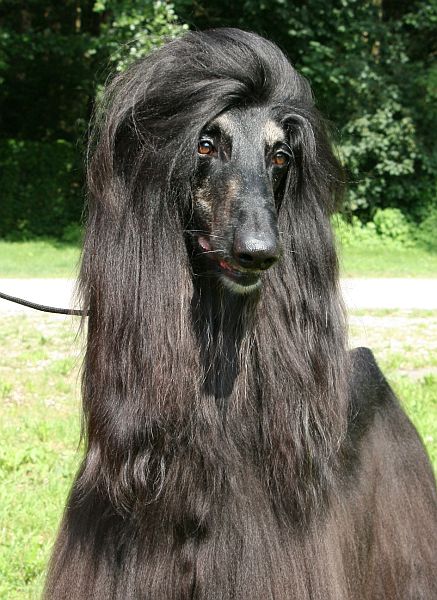 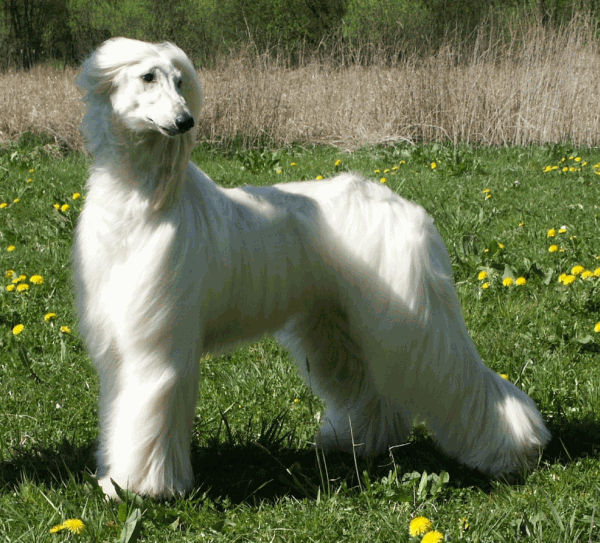
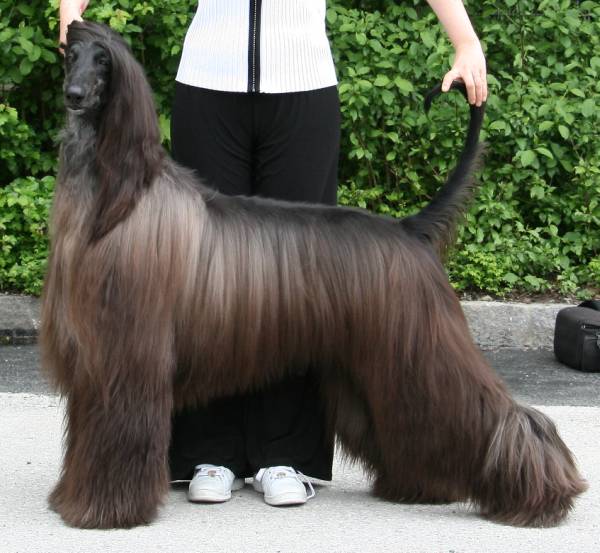 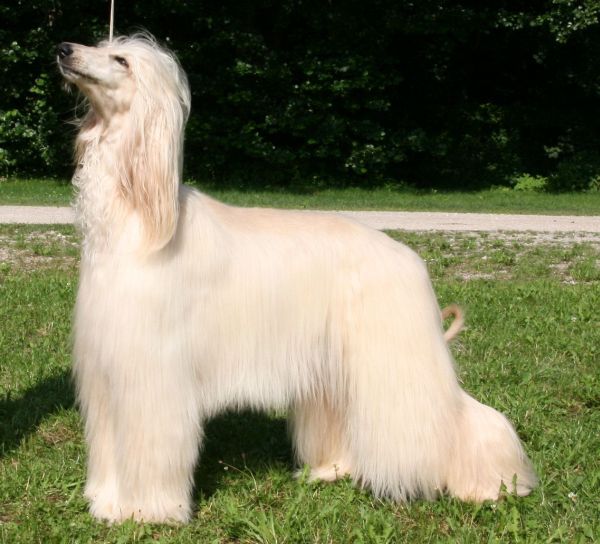
But even a shaved Afghan hound is a
beautiful hound!
Without coat you can see his athletic body and muscles!
The old ones enjoy to be shaved, because they need very less bath
and
they have to stand on the grooming table for a very short time to
get ready!
Also if you have no time or don`t come along with grooming
your Afghan Hound, a nice hair-cut could be the alternative!
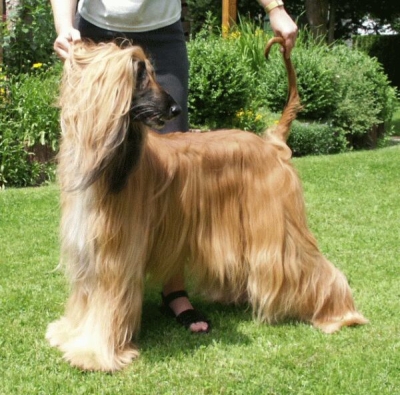 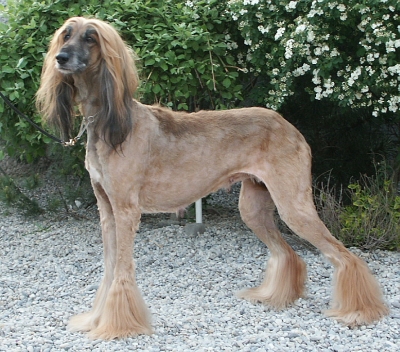
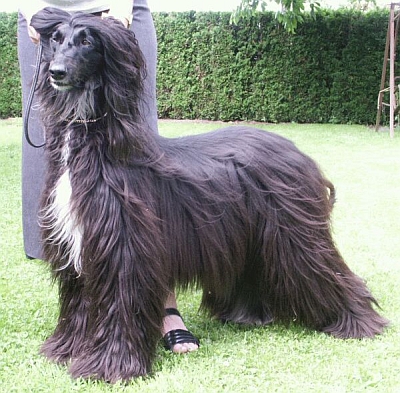 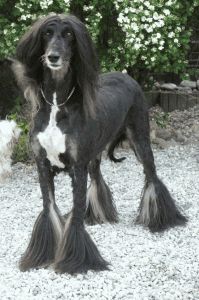
An Afghan Hound in coat needs to be bathed and blow dried and brushed out.
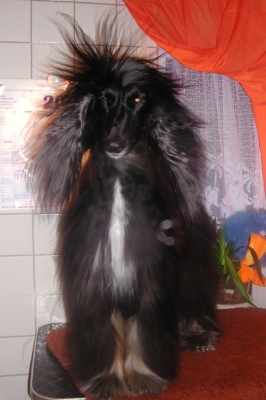
They
don’t need to be clipped unless you want less hair.
If you frequently bath your Afghan Hound once a week or two,
you will have less work and the grooming becomes a routine!
A good groomed dog doesn`t need a lot of brushing between the next
bath!
A bitch in full coat needs about 2-3 hours
to be groomed,
a male about 2-4 hours!
All depends on the coat quality, the grooming equipment and your
practice!
For a newbie it can take some more hours in the beginning and
especially until the Afghan Hound puppy
has changed it`s coat into the adult coat!
But we are always there to help!
They should always be bathed in a high
quality shampoo and conditioner.
There are a lot of good brands on the market.
We use Laser Lite from Australia!
What you also need is a grooming table, a
hand dryer ( we use stand dryers),
a good pin brush without ball tips, a comb and for some parts a
slicker brush!
Later you need also a trimming knife for the saddle and a nail
clipper!
|
| |
More stuff to read about the Afghan Hound....
A summery of descriptions of the Afghan Hound
found in the WWW...
Introduction
True to his mountain heritage, the Afghan
Hound is a tough, agile dog capable of climbing rocky outcrops and
dodging around and over boulders. His large feet give him great support
for twists and turns as he trails large game and dodges the hoofs and
teeth of cornered animals. Because his unusually wide, high hip bones
give great maneuverability (found in no other breed), the Afghan makes
an excellent hunting hound, particularly in rough, uneven terrain.
He is well-suited for cold, wet, windy
climates. Swift enough to outdistance mounted hunters, the Afghan is of
necessity a courageous hunter and an independent thinker, capable of
holding large prey at bay until the hunter arrives.
Although there is some evidence of Afghan
Hounds outside Afghanistan after the Indian-Afghani border wars in the
late 19th Century and early 20th Century, an English officer stationed
near Kabul was the first documented Western breeder of the dogs. Afghans
from his Ghazni kennel went to England in 1925, and the breed made its
way to the US a few years later. Zeppo Marx of the famous Marx Brothers
was an early fancier; he and his wife imported two dogs from England
that eventually became the foundation of Pride's Hill Kennel in
Massachusetts and the keystone of the breed in America. The American
Kennel Club recognized the Afghan Hound in 1926 and the Afghan Club of
America became an AKC member club in 1940.
The Afghan is a study in contradictions.
Beautiful in an aristocratic way, the breed is at heart and by heritage
a sighthound, bound to course after cats in the yard, rabbits in the
park or gazelles in his homeland. By appearance an ornament and by
nature a guardian of the hearth, the Afghan's demeanor runs the gamut
from jittery to dignified to merry.
There's no doubt that the Afghan is an
ancient breed, a sighthound rising from the mists of time among the
nomadic peoples of the Middle East. The mountain tribes that developed
the breed to hunt large and small game were a conglomeration of people
with a variety of customs and cultures. Much of the breed history has
been lost as warlike factions led by the likes of Alexander the Great
and Genghis Khan overran the country from time to time and Mohammedans
labeled the animals as repugnant and impure. There is evidence that the
dogs were of two basic types reflecting the terrain and climate in which
they developed, but isolated tribes had their own varieties that
differed by color and coat description.
The desert dogs more closely resemble the
Saluki, a thin, short-coated sighthound. The mountain variety of the
breed is shorter in height, longer and thicker of coat, and chunkier of
muscle. The American show dogs resemble the mountain type dogs.
Silky coat flowing, the Afghan Hound is a high society dog, at home with Rolls Royces, fashionable
furs, cashmere sweaters, and Cartier jewelry.
Far-removed from his birth
in rugged Afghanistan, the dog brings a regal appearance and attitude to
every space he occupies, every relationship he joins, and every job he
does.
Appearance
The Afghan Hound Standard describes the dog
as an aristocrat with a proud carriage, silky top-knot, prominent
hipbones, large feet, peculiar coat pattern, and somewhat exaggerated
bend in the stifle joint of the rear leg. Males should be 27 inches at
the shoulder and bitches 25 inches; a deviation of an inch in either
direction is acceptable. Males should weigh about 60 pounds, females
about 50 pounds. (By comparison, the Akita is approximately the same
height and weighs about twice as much.)
The dog is truly elegant, without a trace of
coarseness in structure or coat. His head is long and refined with a
slight convex or Roman appearance. His skull is crowned with a flowing
headdress that blends in with the long ears and gives the appearance of
smooth, satiny well-groomed hair.
As tall at the shoulders as he is long
in body, the dog is a picture of atheltic power well-clad in a unique
coat. Fine, silky hair covers his hindquarters, flanks, ribs,
forequarters, and legs in a thick blanket, and short hairs cover his
back from the withers to the tip of his tail. The coat is not trimmed;
the saddle of short hairs is natural. The tail has a curve or ring on the
end, but is not carried over the back.
The Afghan can be any color from the pale
cream or gray to deep black. The brindle pattern -- light stripes on a
dark background or dark stripes on a light background -- is acceptable
as are light markings on dark dogs and dark markings on light dogs.
As lovely as the Afghan is while standing
still, it is his movement that takes the breath away.
His stride is
powerful and seemingly without effort; his flowing hair softens the
image of strength and provides style and flair.
Handlers of this breed
get a workout in the show ring as the dogs extend themselves in a
smooth, fluid trot for the judge.
In motion, the Afghan is a work of
fine art, an ethereal natural wonder, a joy to behold.
The Afghan puppy, however, looks like it
belongs to another breed or is of mixed parentage. The long muzzle,
slender legs, silken coat, natural grace, and royal manner are nowhere
in evidence; instead the puppy has a short, broad muzzle; a fluffy coat;
and a wild, carefree attitude. Gradually, his muzzle, legs, and coat
lengthen, his gait looses its puppy awkwardness and his promise becomes
clear.
Care and training
The Afghan is not an easy keeper. His coat
must be brushed regularly to remove dead hairs and prevent mats and
tangles.
Puppy coats need brushing as they lengthen, so youngsters must
be accustomed to grooming from the moment they enter the family.
Somewhere between his 10th and 18th months, the Afghan loses his puppy
coat. The process takes a month or more; during this time, the dog
should be completely examined daily for tiny tangles that can grow into
large mats in short order. As the dead hairs fall, they catch in the
remaining hairs and form tangles next to the skin. If the tangles are
not combed out, they thicken into nightmarish blobs of hair that can
cause skin irritation, require long grooming sessions, and may even need
to be cut out.
Slicker brushes are effective tools for
removing these tangles from the skin out. Brushing or combing the coat
from the outside into the skin can further twist hairs into the
developing mat.
An excellent article by Anna Stromberg about
grooming you can find on the
Grandeur Afghan Hounds Website!
Generally healthy, the Afghan has a low
incidence of hip dysplasia, can suffer from cataracts, and has the
sighthounds' sensitivity to pesticides and anesthesia.
Sighthounds in general are
sensitive to lung torsion.
The dog has a tremendous need for exercise
and should be walked a mile or two each day. Although he is strong,
independent, and intelligent, the Afghan is often shy and sensitive to
harsh correction so must be trained with care. Jerks on the leash and
shrill commands are out and gentle guidance and firm discipline are in.
Obedience training boosts his confidence, intensifies the owner-dog
communication, and controls his boisterous behavior.
The Afghan can be a wonderful companion,
well-matched to an elegant lifestyle.
However, many people are drawn to
the breed's appearance without understanding its need for grooming,
exercise, and gentle training, and the Afghan Rescue Committee winds up
with dogs abandoned because they continually run away, refuse to obey
their owners, or have the audacity to have a matted coat.
Before
choosing an Afghan, buyers should carefully consider the time they have
available to care for this exquisite canine companion.
|